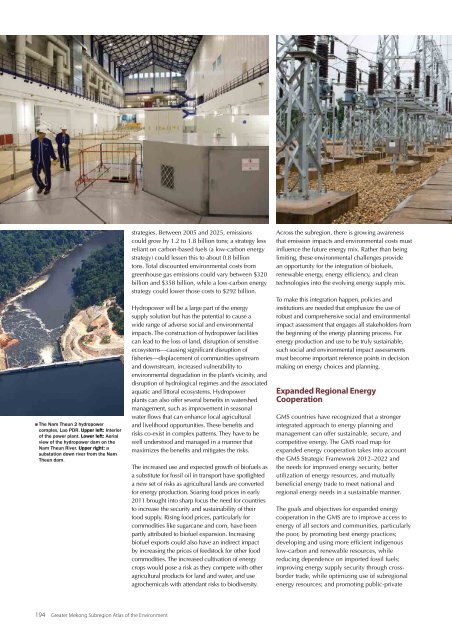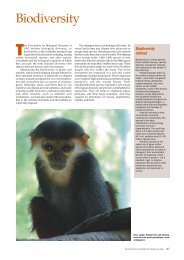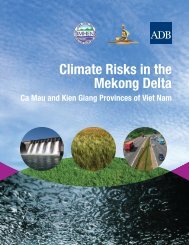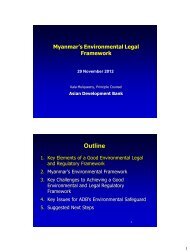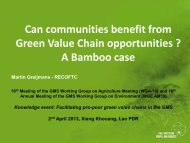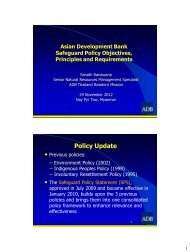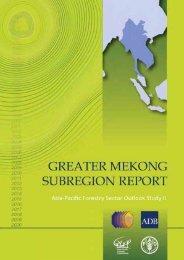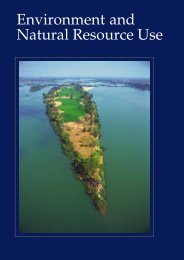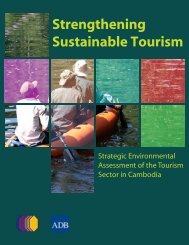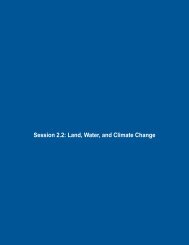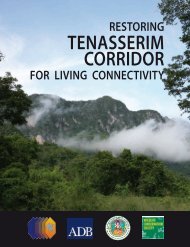Agricultural Land in the GMS (thousand hectare) in ... - GMS-EOC
Agricultural Land in the GMS (thousand hectare) in ... - GMS-EOC
Agricultural Land in the GMS (thousand hectare) in ... - GMS-EOC
Create successful ePaper yourself
Turn your PDF publications into a flip-book with our unique Google optimized e-Paper software.
The Nam Theun 2 hydropowercomplex, Lao PDR. Upper left: Interiorof <strong>the</strong> power plant. Lower left: Aerialview of <strong>the</strong> hydropower dam on <strong>the</strong>Nam Theun River. Upper right: asubstation down river from <strong>the</strong> NamTheun dam.strategies. Between 2005 and 2025, emissionscould grow by 1.2 to 1.8 billion tons; a strategy lessreliant on carbon-based fuels (a low-carbon energystrategy) could lessen this to about 0.8 billiontons. Total discounted environmental costs fromgreenhouse gas emissions could vary between $320billion and $358 billion, while a low-carbon energystrategy could lower those costs to $292 billion.Hydropower will be a large part of <strong>the</strong> energysupply solution but has <strong>the</strong> potential to cause awide range of adverse social and environmentalimpacts. The construction of hydropower facilitiescan lead to <strong>the</strong> loss of land, disruption of sensitiveecosystems—caus<strong>in</strong>g significant disruption offisheries—displacement of communities upstreamand downstream, <strong>in</strong>creased vulnerability toenvironmental degradation <strong>in</strong> <strong>the</strong> plant’s vic<strong>in</strong>ity, anddisruption of hydrological regimes and <strong>the</strong> associatedaquatic and littoral ecosystems. Hydropowerplants can also offer several benefits <strong>in</strong> watershedmanagement, such as improvement <strong>in</strong> seasonalwater flows that can enhance local agriculturaland livelihood opportunities. These benefits andrisks co-exist <strong>in</strong> complex patterns. They have to bewell understood and managed <strong>in</strong> a manner thatmaximizes <strong>the</strong> benefits and mitigates <strong>the</strong> risks.The <strong>in</strong>creased use and expected growth of biofuels asa substitute for fossil oil <strong>in</strong> transport have spotlighteda new set of risks as agricultural lands are convertedfor energy production. Soar<strong>in</strong>g food prices <strong>in</strong> early2011 brought <strong>in</strong>to sharp focus <strong>the</strong> need for countriesto <strong>in</strong>crease <strong>the</strong> security and susta<strong>in</strong>ability of <strong>the</strong>irfood supply. Ris<strong>in</strong>g food prices, particularly forcommodities like sugarcane and corn, have beenpartly attributed to biofuel expansion. Increas<strong>in</strong>gbiofuel exports could also have an <strong>in</strong>direct impactby <strong>in</strong>creas<strong>in</strong>g <strong>the</strong> prices of feedstock for o<strong>the</strong>r foodcommodities. The <strong>in</strong>creased cultivation of energycrops would pose a risk as <strong>the</strong>y compete with o<strong>the</strong>ragricultural products for land and water, and useagrochemicals with attendant risks to biodiversity.Across <strong>the</strong> subregion, <strong>the</strong>re is grow<strong>in</strong>g awarenessthat emission impacts and environmental costs must<strong>in</strong>fluence <strong>the</strong> future energy mix. Ra<strong>the</strong>r than be<strong>in</strong>glimit<strong>in</strong>g, <strong>the</strong>se environmental challenges providean opportunity for <strong>the</strong> <strong>in</strong>tegration of biofuels,renewable energy, energy efficiency, and cleantechnologies <strong>in</strong>to <strong>the</strong> evolv<strong>in</strong>g energy supply mix.To make this <strong>in</strong>tegration happen, policies and<strong>in</strong>stitutions are needed that emphasize <strong>the</strong> use ofrobust and comprehensive social and environmentalimpact assessment that engages all stakeholders from<strong>the</strong> beg<strong>in</strong>n<strong>in</strong>g of <strong>the</strong> energy plann<strong>in</strong>g process. Forenergy production and use to be truly susta<strong>in</strong>able,such social and environmental impact assessmentsmust become important reference po<strong>in</strong>ts <strong>in</strong> decisionmak<strong>in</strong>g on energy choices and plann<strong>in</strong>g.Expanded Regional EnergyCooperation<strong>GMS</strong> countries have recognized that a stronger<strong>in</strong>tegrated approach to energy plann<strong>in</strong>g andmanagement can offer susta<strong>in</strong>able, secure, andcompetitive energy. The <strong>GMS</strong> road map forexpanded energy cooperation takes <strong>in</strong>to account<strong>the</strong> <strong>GMS</strong> Strategic Framework 2012–2022 and<strong>the</strong> needs for improved energy security, betterutilization of energy resources, and mutuallybeneficial energy trade to meet national andregional energy needs <strong>in</strong> a susta<strong>in</strong>able manner.The goals and objectives for expanded energycooperation <strong>in</strong> <strong>the</strong> <strong>GMS</strong> are to improve access toenergy of all sectors and communities, particularly<strong>the</strong> poor, by promot<strong>in</strong>g best energy practices;develop<strong>in</strong>g and us<strong>in</strong>g more efficient <strong>in</strong>digenouslow-carbon and renewable resources, whilereduc<strong>in</strong>g dependence on imported fossil fuels;improv<strong>in</strong>g energy supply security through crossbordertrade, while optimiz<strong>in</strong>g use of subregionalenergy resources; and promot<strong>in</strong>g public-private194 Greater Mekong Subregion Atlas of <strong>the</strong> Environment


